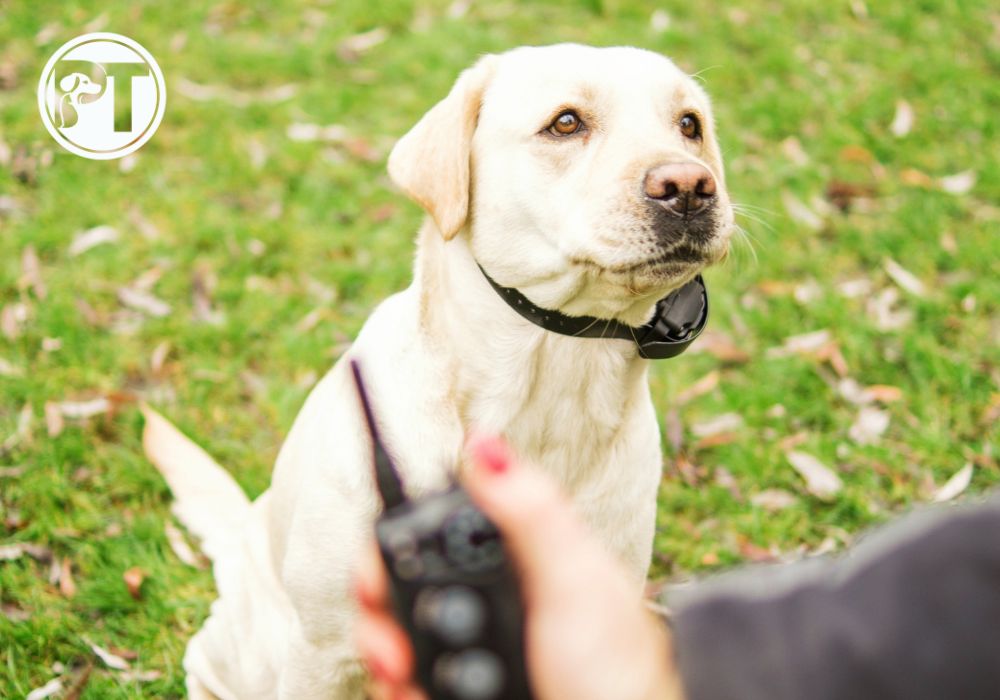What Does a Dog E-Collar Do? Functions, Benefits & Safe Training Guide

With an e-collar, training your dog becomes a smoother, more efficient process. No more chasing squirrels or ignoring your commands – just clear communication between you and your canine companion.
However, before diving headfirst into using an e collar, understanding its inner workings is important. Like understanding the mechanics of a car before driving, grasping the components and functions of an e collar empowers effective dog training.
What are E Collars for Dogs?
E collars are training tools worn by dogs. They have receiver collars that pick up signals from a remote transmitter controlled by the trainer. These signals can vary from vibrations and tones to static stimulation, all intended to assist in behavior modification and training.
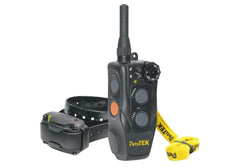
Evolution of E-Collars
Modern e-collars are often confused with their outdated shock collar counterparts. While obsolete shock collars delivered an often painful electrical shock, e-collars offer a much more humane form of stimulation. These modern tools typically utilize gentle vibrations, beeps, or even low-level electrical pulses that are adjustable to suit dog sensitivities.
Despite advancements, e-collars still face criticism, often stemming from misconceptions. However, when used responsibly and under professional guidance, e-collars can be a safe and effective training tool.
Why Do You Need to Understand the Anatomy of an E-Collar?
Understanding the anatomy of an e-collar goes beyond simply knowing its parts or what button to press. It's about comprehending the intricacies of a sophisticated tool designed to enhance communication between you and your dog.
Here’s why delving into the anatomy of an e-collar is so crucial for anyone considering its use:
-
Tailored Training Approaches
Dogs have individual personalities, learning styles, and thresholds for stimulation. An intimate knowledge of an e-collar device allows trainers and pet owners to customize the training approach. Tailoring the intensity and type of feedback (beep, vibration, or static) to your dog's needs can significantly improve training outcomes.
For instance, a high-energy Border Collie might respond well to low-level static correction as a reminder during training. Meanwhile, a more sensitive Golden Retriever might benefit from a gentle vibration.
- Enhanced Communication
Effective e collar dog training is grounded in clear, consistent communication. Understanding the components and functionalities of the e-collar empowers you to transmit precise corrections to your dog. This clarity helps to reinforce desired behaviors and correct unwanted ones in a way that is clear and understandable to your dog.
Picture this: You're training your dog to stay off the counter. As your dog paws at the edge, a gentle vibration from the e collar instantly alerts them to their misstep. This clear signal allows you to intervene immediately and redirect your furry friend’s undesirable behavior.
- Preventing Misuse
A lack of understanding about how e-collars work can lead to misuse. This can include over-reliance on static stimulation or using higher levels of intensity than necessary. This not only undermines the training process but can also lead to negative outcomes.
Components of an E-Collar Unit
I. The Remote Transmitter
The transmitter is like a remote control for the e-collar, letting you communicate with your dog during training. It's small, fits in your hand, and has buttons or dials to manage how you guide or correct your dog.
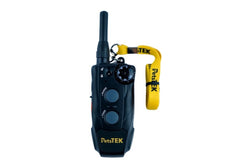
Key Parts of the Remote Transmitter
1. Intensity ControlDifferent e collar models offer various ways to adjust the intensity settings. These are the two common types:
- Dial Control: Some models feature a dedicated intensity dial on the transmitter. This dial allows you to easily rotate it clockwise to increase the intensity or counter-clockwise to decrease it. You may feel a clicking sensation as you adjust, and sometimes the current level might be displayed on the transmitter’s screen.
- Button Control: Other models use dedicated buttons with a digital display. Pressing the "up" or “+” button increases the intensity level, while the "down" or “-” button decreases it. The current level is typically displayed on the screen, allowing you to visually confirm the setting.
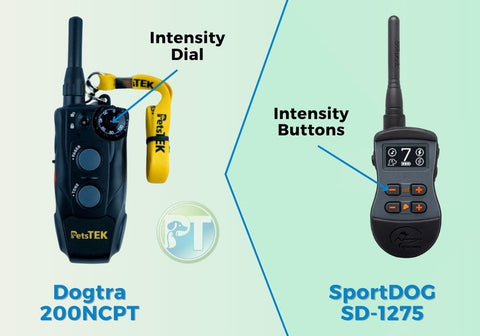
To understand your specific model's design, refer to the user manual. It usually provides detailed instructions on using the controls, including adjusting intensity.
2. Stimulation Type Buttons
E-collars often have dedicated buttons for each type of stimulation they offer, typically vibration, tone (beep), and static correction. These buttons allow you to respond instantly to situations requiring correction or communication during training.
- Easy to Locate and Press: These buttons are typically prominently placed on the transmitter, often larger and readily identifiable compared to other buttons. They are also designed to be easy to press, allowing for one-handed operation while training.
- Enhanced Clarity with Color-Coding or Labels: Some e-collars employ color-coding for the stimulation buttons. For example, a black button may represent vibration, while a red one may represent static. Others use clear labels directly on the buttons, such as "V/T" for vibration and tone and “S” for static.

3. Display Screen (if applicable)
While not all e collar transmitters come with a display screen, advanced models often feature one, providing valuable information. A display screen may show:
- Current stimulation level - often displayed as a numerical value or a visual indicator like bars
- Battery life indicator - uses a battery icon or percentage to indicate the remaining battery life of the transmitter
- Transmitter/receiver connection status - a symbol or indicator showing a connection status between the transmitter and the receiver collar
- Training mode settings - Advanced e-collars might offer different training modes with varying stimulation delivery methods. The display might show the currently selected mode, such as “C” for continuous, “M” for momentary, and “V” for vibration-only)
4. Antenna
The antenna on an e collar transmitter is essentially responsible for transmitting the signals you select (vibration, beep, or static) to your dog's collar receiver. The antenna directly influences the reach of this signal, determining the maximum range over which your e-collar can function effectively. These antennas protrude from the transmitter, usually as a flexible whip or rod.
5. Power ButtonThis button serves as the on/off switch for your e-collar transmitter. It typically stands out on the transmitter, often bigger than the other buttons, making it easy to find and press.
6. Magnetic Red Dot (Optional)
In some ecollar models, the primary function of the magnetic red dot is to pair the transmitter and receiver collar. This can be done by simply touching the red dot on the transmitter to the corresponding red dot on the receiver collar. The devices “recognize” each other, establishing a secure connection.
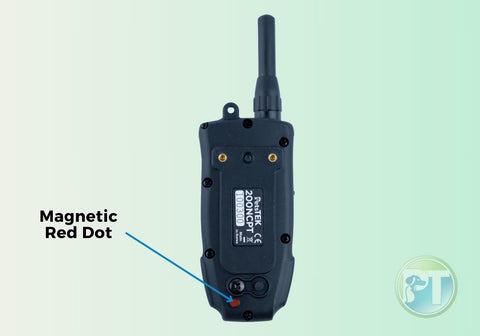
Note: Instead of magnetic red dots, some models use on/off switches or other pairing methods.
7. Transmitter Indicator Light
This serves as a visual cue that provides helpful insights into the status of your remote transmitter.
- Battery Status: The light might change colors (green, orange, red) to indicate the remaining battery life of your transmitter.
- Signal Transmission: The light may blink or flash when a button is pressed on the transmitter, confirming that the signal is being sent to the receiver collar.
8. Lanyard Loop
This small loop, typically located on the side or bottom of the transmitter, allows you to secure the device with a lanyard. Lanyards allow you to wear the transmitter around your neck or shoulder, keeping it within easy reach while training. This is particularly helpful during active training sessions, as it also prevents accidental dropping.
9. Belt Clip (Optional)
Not all e collar remotes come with a belt clip, but some models offer this as an optional feature. This clip allows you to attach the transmitter directly to your belt for even greater convenience and accessibility. Similar to the lanyard loop, the belt clip keeps the transmitter within reach while ensuring it's secure and readily available.
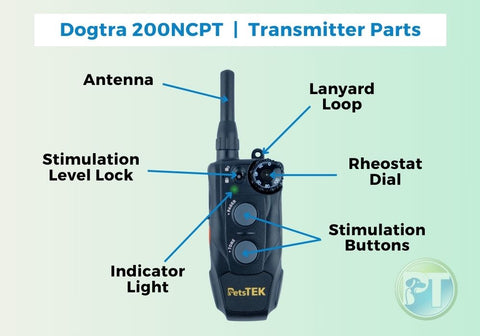
Note: Specific button layouts, features, and design elements vary between e-collar brands and models. Always refer to the product's user manual for detailed instructions tailored to your specific e-collar transmitter.
II. The Receiver Collar
The receiver collar is a vital component of an e-collar system that sits directly on your dog's neck. It acts as the receiving end of the communication between you and your canine companion.
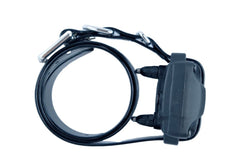
Key Parts of the Receiver Collar
1. Receiver Unit
The receiver unit is the heart of the collar. It houses the electronic components responsible for receiving the signal from the transmitter and delivering the chosen stimulation. This unit usually comes with a waterproof and shockproof casing to withstand various training environments.
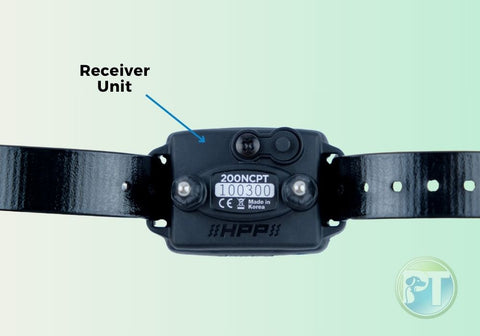
2. Contact Points
Typically, these are small metal points that come in direct contact with your dog's skin to deliver the chosen stimulation. While stainless steel is the most common material for contact points, other options exist for sensitive pups:
- Titanium Contact Points: This lightweight and biocompatible metal offers an even hypoallergenic option, further minimizing the risk of skin irritation.
- Plastic Contacts: Some dog training e collars may also come with plastic contact points. These are gentler on delicate skin, particularly designed for dogs with sensitive skin.
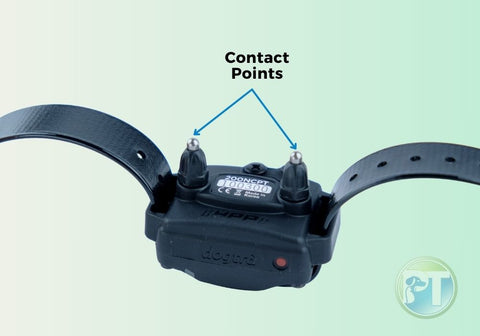
3. Collar Strap
This adjustable strap secures the collar comfortably around your dog's neck. It can be made of nylon or other durable materials with a buckle or clasp for easy attachment and removal. It may come in different sizes to fit various dog breeds and neck sizes.
4. Receiver Indicator Light
The receiver collar on your e-collar also features an indicator light, acting as a vital communication tool during training sessions.
- Battery Status: Similar to the transmitter, the light on the receiver may change color to indicate the battery life.
- Signal Reception: The light may flicker when a signal is received from the transmitter, confirming the collar is picking up the commands.
- Pairing Status: The receiver indicator light will blink to show if the receiver is successfully paired with the transmitter.
5. Battery Compartment
The battery compartment, located on the underside or back of the receiver unit, houses the battery that powers the unit. This may be accessible through a secure latch or screw mechanism.
The specific battery type and lifespan can vary depending on the model. Some models utilize rechargeable lithium-ion batteries, while some use replaceable batteries that require periodic replacement with new ones.
6. Magnetic Red Dot (Optional)
In some models, the magnetic red dots act as an easy way to turn the receiver collar on and off. By touching the dots together, you can power the receiver unit on and, at the same time, sync it with the transmitter.
Note: Instead of magnetic red dots, some models have on/off switches and use other pairing methods.
7. On/Off Button (Optional)
Some advanced receiver collars might have a power button to turn the device on and off. This allows you to conserve battery life when not in use. Consult the user manual for specific instructions on operating this feature, as not all models offer it.
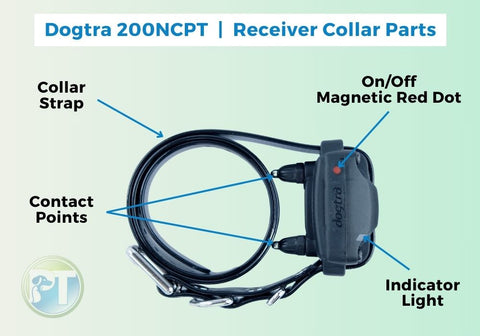
Remember, specific features and design may vary between brands and models. Always refer to the product's user manual for a detailed explanation of the parts and their functions of your e-collar receiver collar.
How an E-Collar Works
Dog training e-collars rely on clear communication between a transmitter and a receiver collar. Here's a breakdown of their basic operation:
- Signal Transmission: When the trainer presses a button on the transmitter, it sends a radio signal to the receiver collar worn by the dog.
- Signal Reception: The receiver collar then picks up the signal, coming from the transmitter remote.
- Stimulation Delivery: Based on the chosen stimulation type and intensity level, the receiver collar translates the trainer's signal into an appropriate response. This may be in the form of a vibration or beep, delivered through the contact points on the dog's skin.
Understanding E-Collar Range
E-collars have a specific operating range within which the signal remains strong and reliable. Range refers to the maximum distance between the transmitter and the receiver collar at which the two devices can effectively communicate. This range can vary depending on the model and terrain, but it's typically within a few hundred yards to a mile (or more).
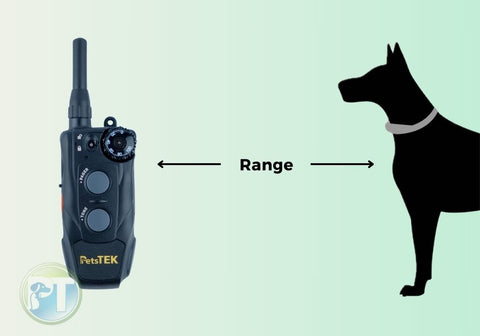
A longer range allows for greater flexibility in where you can train your dog, whether it's a spacious backyard, an open park, or a training field. A substantial range is especially crucial when training hunting dogs in outdoor settings. It helps you maintain control and ensures your dog's safety. With a more extensive range, you can correct or recall your dog from a distance, preventing potential dangers such as running onto roads or getting lost.
Types of Stimulation or Feedback
E-collars for dogs offer various types of stimulation and feedback to communicate with your dog. Below are the commonly available options:
- Vibration
This is a non-static option that can grab a dog's attention or signal a command without using static stimulation. It's a good choice for sensitive pups or those that have hearing impairment.
- Beep/Tone
This is often used as a warning or cue for specific behaviors, building a conditioned response without static stimulation.
- Static Stimulation
This is a stronger signal for more direct commands or highly distracting situations. Most ecollars with this option offer two key features for customized correction:
- Continuous stimulation - delivers a steady buzz for a predetermined duration, typically used for stubborn dogs
- Momentary (Nick) stimulation - delivers a single, short buzz upon button press, ideal for gentle reminders or initial corrections
Note: Not all dog e collars have all three options. Some may only have vibration, tone, or static correction.
How Long Does the Stimulation Last?
E-collars give you the ability to control the duration of each feedback you send to your dog. This means you're in charge of how long your dog feels the vibration, beep, or static stimulation.
However, for added safety, many modern e collars come equipped with an automatic shutoff feature. This ensures the stimulation never continues for an extended period, even if you accidentally hold the button too long. This shutoff typically activates after 8-12 seconds, depending on the e collar brand.
Adjustable Nature of Stimulation
E-collars typically offer adjustable levels of stimulation. This ensures that you can find and use the lowest effective level of correction for your dog's sensitivity and the situation's demands. This means you can make the stimulation very gentle for a sensitive dog or stronger for a dog that might need a clearer signal.
Best E Collars for Dogs
If you're considering using an e-collar, we have a few suggestions in mind. For beginners, it’s always best to consult a dog trainer first for proper guidance.
1. ET-300 Mini Educator by E-Collar Technologies
The ET-300 Mini Educator is a popular choice among dog owners and trainers. It has a ½-mile range and 100 levels of static stimulation. It also comes with a tone and vibration, ideal for sensitive and hearing-impaired dogs. This shock collar is fully waterproof and rechargeable, available in yellow, black, and Educator Zen 300 variants.
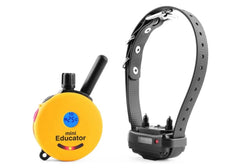
2. Dogtra 200NCPT PetsTEK Edition
The Dogtra 200NCPT is an excellent choice for small to medium dogs. It has a 1/2-mile range, 100 stimulation levels, an audible tone, and non-stimulating vibration. Best for dogs as small as 12 pounds, it’s an e collar for basic obedience lessons and off-leash training.

3. ET-800 Boss Educator by E-Collar Technologies
The Boss Educator ET-800 is designed for large and stubborn dogs. It has a 1-mile range, 100 levels of static, and 60 levels of boost. This e collar also comes with tone and vibration for sensitive canines. It’s a waterproof collar, recommended for dogs 20 pounds and larger.
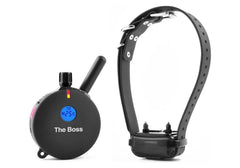
4. SportDOG SD-425X FieldTrainer
Built for basic training and hunting, the SD-425X FieldTrainer is the smallest shock collar by SportDOG. It has a 500-yard range, 21 static levels, and other training options, including tone and vibration. This is an expandable trainer for up to 3 dogs.
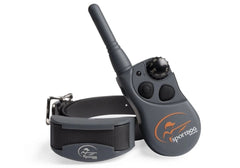
5. Dogtra 1900S
The Dogtra 1900S is known for its versatility and durability. Whether for obedience, competition, or K9 training, this e collar is dependable, with 127 levels of stimulation. Great for dogs 35 pounds and larger, this ecollar has a 3/4-mile radius and is fully waterproof. It also comes in a camo and black finish, as well as the Handsfree Plus version.

Wrap Up
Understanding the components of an e-collar is essential for effective dog training. If you’re a beginner, we encourage seeking professional guidance before integrating an e-collar into your training regimen.
Stay tuned for our next topic in the "Know Your E-Collar Series,” where we'll explore the importance and variations of e-collar straps. Remember, understanding your tools is the first step towards effective and responsible e collar training.
You might also enjoy...
-
Posted in
Dog Training, E-Collar Info & Guides, Remote Training Collar

